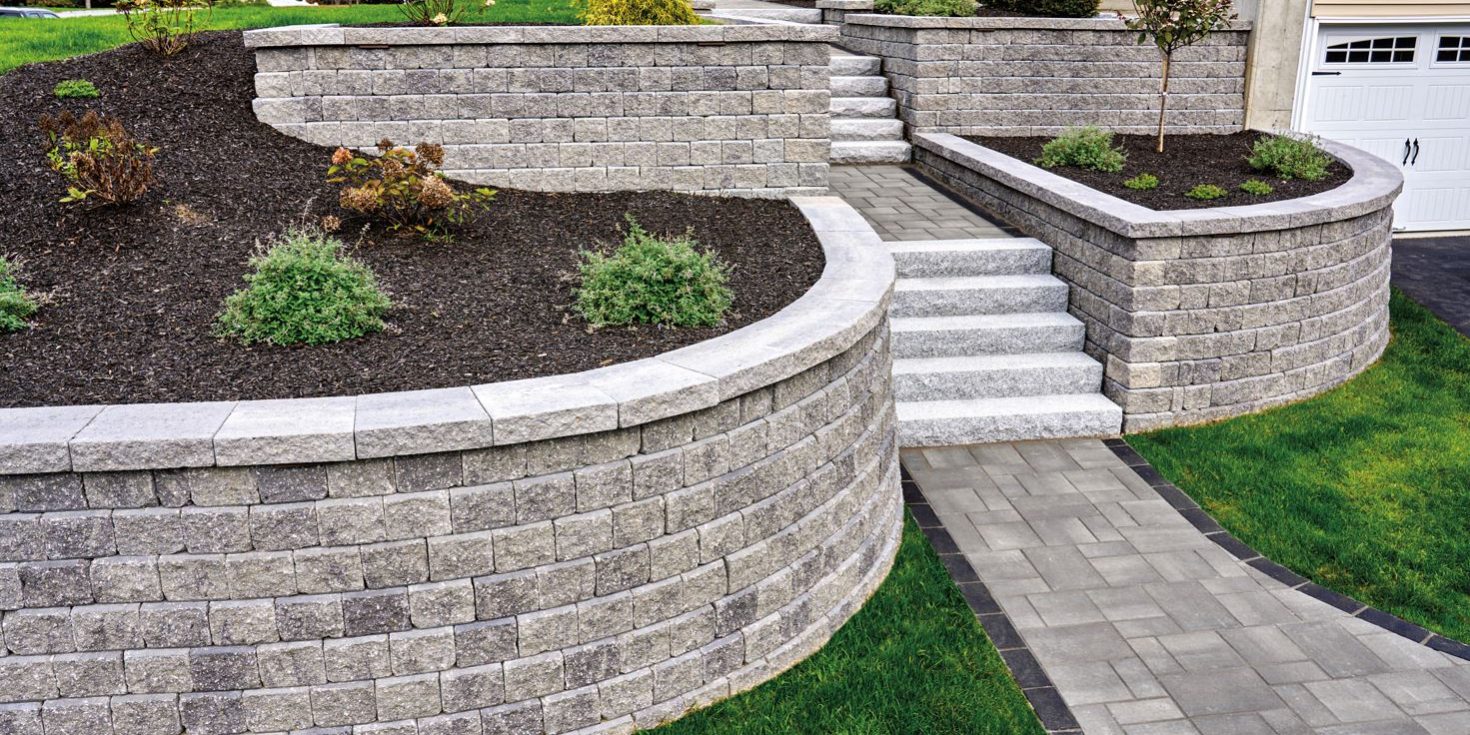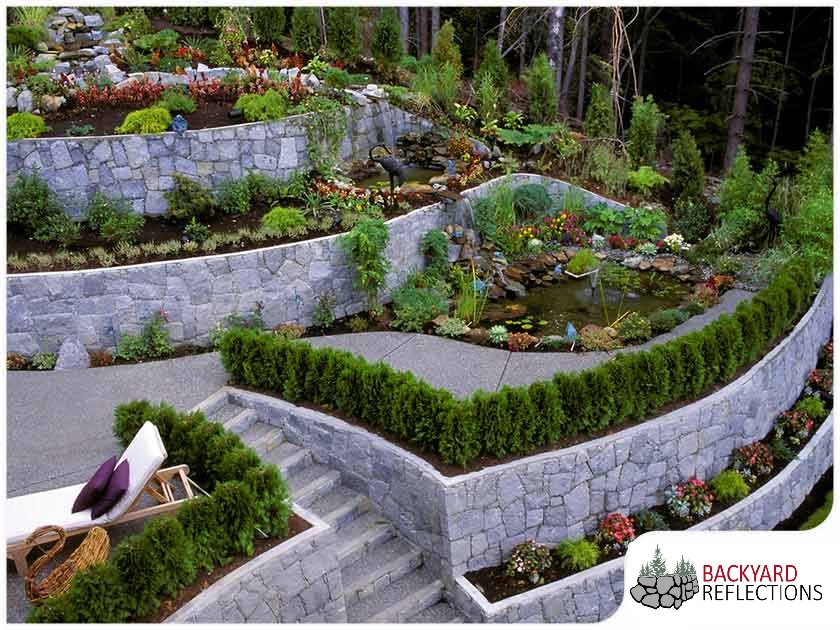Key Considerations for Structure Efficient Retaining Walls in Your Yard
When you're considering constructing a keeping wall in your yard, it's essential to consider several essential variables. The wall surface's function, the materials you'll make use of, and the particular soil problems can all affect its efficiency and longevity. You'll additionally need to browse regional building ordinance and strategy for appropriate drain. But just how do you guarantee your layout not only fulfills these needs yet also boosts your landscape? Let's discover the necessary steps with each other.
Recognizing the Purpose of Your Retaining Wall
When you believe regarding developing a retaining wall, consider its primary objective: maintaining soil and stopping disintegration. Retaining walls supply important assistance for sloped landscapes, aiding to maintain soil integrity. You'll discover they're vital in areas where water overflow could or else remove soil, causing pricey repair work and landscape damages.
By keeping back planet, these walls develop degree surface areas for yards, outdoor patios, or pathways. This not only improves your lawn's looks yet likewise advertises far better water drainage, reducing water pooling in unwanted locations. If you're dealing with high inclines, a sound retaining wall surface can avoid landslides, guaranteeing security for you and your residential property.
Ultimately, comprehending the function of your retaining wall will direct your design decisions and help you create a useful, sturdy framework that satisfies your requirements. Take a moment to evaluate your landscape; it'll pay off in the lengthy run.
Picking the Right Materials
When selecting products for your retaining wall, you'll intend to think about resilience, appearances, and expense. Each element plays a vital function in ensuring your wall surface stands the test of time while looking excellent and fitting your budget. Let's check out just how to make the most effective selections for your job.
Product Longevity Aspects
Selecting the best products is crucial for the longevity and performance of your retaining wall, considering that their sturdiness directly influences the wall's capacity to endure environmental anxieties. Start by considering your local environment; materials like concrete and rock resist dampness and temperature variations well. If you stay in an area vulnerable to hefty rains, choose products with great drainage properties, like crushed rock or porous blocks, to avoid water buildup.
Some materials execute far better in details dirt types, so it's essential to match them appropriately. Picking durable products guarantees your retaining wall stands solid, shielding your yard for years to come.
Aesthetic Layout Selections
Durable materials not only guarantee your retaining wall's structural honesty but also play a key role in its visual appeal. When choosing the best products, assume concerning just how they match your landscape. Natural stone provides an ageless, rustic appearance, while cinder block can supply a smooth, contemporary finish. You might additionally consider utilizing wood for a warm, natural feeling. Color and texture issue, too; choose tones that integrate with your home and garden. Don't forget concerning the wall surface's form-- rounded walls can produce a softer appearance, while straight lines can really feel a lot more structured. By thoroughly selecting materials that straighten with your aesthetic vision, you'll boost your exterior area while guaranteeing your wall surface stands strong versus the aspects.
Cost-Effectiveness Evaluation
Picking the best products for your retaining wall isn't just about looks; it's additionally important for your budget plan. When selecting products, think about both upfront costs and long-term toughness.
Do not neglect to variable in upkeep prices too (OKC Precision Retaining Walls). Some materials, like natural stone, can include beauty and require less upkeep, while others could require normal therapies
Inevitably, weigh the advantages and disadvantages of each option versus your budget and the wall's desired objective. Spending wisely in products currently can protect against pricey problems later on. Select materials that balance cost and efficiency properly.
Analyzing Dirt Conditions and Drainage
As you begin your project, assessing soil problems and drainage is important for the success of your retaining wall. Sandy soil drains well but does not have security, while clay soil can preserve moisture, leading to push on your wall.
Next, evaluate the slope of visit here your lawn. If water normally flows toward your wall surface, you'll require to carry out a drainage service to avoid erosion and pressure build-up. Consider setting up perforated pipelines or crushed rock backfill behind the wall to promote water drainage.
Last but not least, observe any type of neighboring trees or vegetation; their origins can affect dirt stability. By recognizing your soil problems and executing correct drainage, you'll produce a solid foundation for your retaining wall that stands the examination of time.
Adhering To Local Structure Codes
Prior to you start building your retaining wall, you require to research study local policies to guarantee conformity. It's vital to comprehend what allows you need to get, as this can save you from costly penalties or having to remodel your job. Taking these steps seriously will assist you develop a risk-free and reliable structure.
Study Local Rules
Recognizing local laws is essential when planning your retaining wall surface project, particularly because constructing codes can vary substantially by area. Beginning by consulting your regional building department or municipality to discover regarding particular needs. Try to find guidelines on wall elevation, products, water drainage systems, and structural honesty. Numerous locations have restrictions on the sorts of materials you can utilize and how high you can develop. You'll additionally desire to take into account the zoning legislations that might influence your job. Disregarding these regulations can bring about expensive fines or the need to remodel your job. By doing your research upfront, you can assure your retaining wall fulfills all needed codes and blends perfectly right into your lawn.
Get Necessary Licenses
As soon as you have actually investigated neighborhood regulations, the following action is to obtain the necessary permits for your retaining wall surface task. They might need certain plans or engineering analyses, particularly for bigger walls. Securing the right approvals can conserve you from costly fines or having to dismantle your wall later on.

Planning the Design and Appearance
As you start intending the layout and aesthetic appeals of your retaining wall surface, consider exactly how it will integrate with the bordering landscape. Think of the materials you'll make use of-- rock, brick, or concrete-- and how they'll enhance your home's style and the natural environments in your lawn. Choose shades and structures that blend flawlessly with existing functions like patios, paths, or yards.
Following, envision the wall's shape and elevation. Curved walls can soften a rigid landscape, while straight lines might communicate a more modern-day look. Don't forget to include plants and plant around the wall surface for an all-natural touch; this can boost its appeal and incorporate it right into the setting.
Finally, bear in mind performance. Your style should not only be visually pleasing yet also offer its objective successfully. By thoughtfully planning these elements, you'll produce a retaining wall surface that improves your backyard's beauty while meeting its structural role.
Determining Elevation and Thickness Demands
To build a strong retaining wall, you need to properly determine its height and thickness needs based upon the soil problems and the elevation of the incline it will certainly sustain. Begin by assessing the slope's angle and the kind of soil, as different soils apply varying amounts of stress.
For walls over 4 feet high, think about a density of at the very least 12 inches. If the wall surface is taller, raise the density proportionally to maintain stability.
Next, compute the elevation of the wall by determining the vertical range it requires to preserve. For every single foot of elevation, you ought to generally prepare for a density of one-third of the wall's elevation.
Always bear in mind to represent extra variables like drainage and backfill, which can affect your wall surface's style. Correct computations currently assure your retaining wall stands strong and lasts for several years to come.
Maintenance and Longevity Factors To Consider
While preserving your retaining wall surface could appear like a reduced priority, disregarding it can result in significant concerns with time. Regular assessments are necessary; check for fractures, protrudes, or any kind of signs of water damage. Addressing these issues early can site link save you from costly repair services down the my response road.
Keep an eye on water drainage systems, too. Clogged drains can cause water to accumulate, applying pressure on your wall surface and compromising its stability. Clear debris and warranty appropriate circulation to keep longevity.
You may also intend to assess securing your wall surface to shield it from dampness and weathering. Depending on the product, this may call for reapplication every few years.
Last but not least, landscaping around your wall surface can support its integrity. Prevent growing huge trees close by, as their origins can threaten the structure. With positive maintenance, your retaining wall can serve you well for several years to find.

Often Asked Inquiries
Can I Construct a Retaining Wall by Myself, or Should I Hire a Specialist?
You can absolutely develop a maintaining wall on your own if you have the right devices and expertise. However, hiring an expert guarantees it's done appropriately, specifically for bigger or more complex structures. Consider your skill level prior to determining.
What Are the Most Usual Blunders Made When Structure Retaining Walls?
When constructing retaining walls, you could forget correct drain, miss using the best products, or forget support. These typical blunders can cause architectural failure, so take your time and plan meticulously to stay clear of concerns.
How Do I Know if My Retaining Wall Demands Reinforcement?
You'll know your retaining wall requires support if you see splits, leaning, or protruding. Inspect for water merging behind it or dirt disintegration near the base. Address these indications without delay to protect against additional damages.
What Plants Appropriate for Landscaping Around a Retaining Wall?
When landscape design around a keeping wall, take into consideration utilizing low-maintenance plants like succulents, decorative yards, or slipping ground covers - OKC Precision Retaining Walls. They'll flourish in those conditions and include beauty while protecting against soil erosion around your wall surface
How Can I Stop Erosion Around My Retaining Wall?
To stop erosion around your retaining wall, you can plant ground cover, use mulch, and set up water drainage systems. Frequently inspect for water accumulation and adjust landscape design to reroute drainage away from the wall surface.